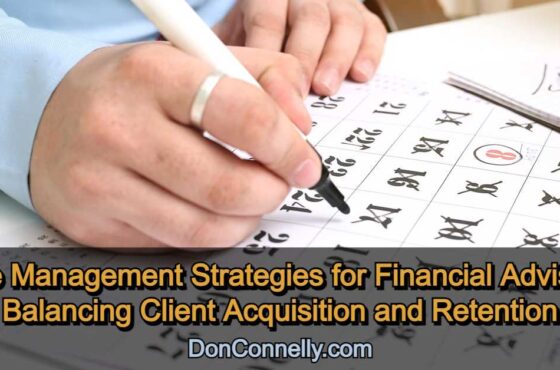A Guide to Securing Second Meetings with Prospects: Turning First Impressions into Lasting Partnerships
 It’s no exaggeration to say that the initial meeting with a prospective client is a make-or-break moment that sets the tone for the relationship and determines whether it will continue in a second meeting. The initial meeting is a crucial dance between the advisor and a naturally skeptical prospect who wants to know why they should work with you.
It’s no exaggeration to say that the initial meeting with a prospective client is a make-or-break moment that sets the tone for the relationship and determines whether it will continue in a second meeting. The initial meeting is a crucial dance between the advisor and a naturally skeptical prospect who wants to know why they should work with you.
In a crowded field of financial advisors, the initial meeting presents a critical opportunity to differentiate yourself. Prospects are likely to meet with multiple advisors. You must make the prospect feel they’re making the right choice in working with you and that they should expect an advisory experience with you that they can’t get from anyone else. That’s a tall order.
But if you’re organized, practiced, and have the end in mind—a second meeting with the prospect—you can make each initial meeting a success.
#1. Prepare for the initial meeting: Preparation is critical
Before the curtain rises on the meeting, a successful advisor has already invested significant time in preparation. This includes:
Understand the prospect: Researching the prospect’s background, profession, and any publicly available financial information paints a preliminary picture. This helps you tailor questions and avoid generic, one-size-fits-all approaches.
Identify pain points: Prospects rarely walk in with a complete understanding of their financial needs. Advisors can anticipate potential concerns and develop relevant conversation starters by researching common challenges in the prospect’s demographic.
#2. Forge a connection: Building trust and rapport
People do business with people they like and trust. The initial meeting is about establishing rapport, building a connection, and creating a comfortable environment where the prospect feels heard and understood.
Be genuinely interested: Ask open-ended questions about the prospect’s life goals, financial concerns, and motivations. Probe a little deeper by finding out the “why” behind their answers and lean in as they tell you. This active listening demonstrates genuine interest and helps uncover their unique situation.
Mirror and match your communication style: Pay attention to the prospect’s communication style and subtly mirror their body language and tone. This creates a sense of connection and fosters a more open dialogue.
Showcase empathy: Acknowledge the prospect’s financial anxieties or uncertainties. Let them know it’s normal and that you’re there to help navigate these challenges.
Tell a story: Telling the “why I’m here” at this point is a powerful connection-builder.
#3. Uncover needs and pain points
A significant part of the first meeting should be dedicated to understanding the prospect’s financial goals, aspirations, and concerns. You should ask insightful, open-ended questions to encourage the prospect to share detailed information about their financial situation, goals, risk tolerance, and past financial planning experiences. Here are some examples:
- What are your short-term and long-term goals?
- What are your concerns about your current financial situation?
- What keeps you up at night financially?
- Have you worked with a financial advisor before? If so, what was your experience?”
Listening attentively and taking notes shows that you’re taking their needs seriously.
#4. Demonstrate value: Positioning yourself as the solution
During the initial meeting, you can provide value by offering insights or suggestions tailored to the prospect’s situation. This might include explaining financial concepts, discussing market trends, or identifying potential areas for improvement in the prospect’s current financial plan. Demonstrating expertise without overwhelming the prospect with jargon can help establish credibility.
Identify early wins: Based on the initial conversation, offer some preliminary insights or suggestions. This could be a basic budgeting strategy, a tool for debt management, or resources for further education on a specific topic.
Highlight expertise: Connect the client’s goals to your specific area of expertise. Do you specialize in retirement planning for small business owners? Does your firm have experience managing wealth for families with young children? Highlight relevant experience to showcase your value proposition.
Outline your process: You should explain your financial planning process clearly and concisely. This includes outlining the steps involved, the time frame, and what the prospect can expect in terms of communication and deliverables. Providing a roadmap helps the prospect understand how you operate and sets clear expectations for the relationship.
#5. Address fees and compensation
Transparency about fees is crucial. It’s essential to explain your fee structure and how you are compensated. Whether it’s a flat fee, hourly rate, or commission-based, the prospect needs to understand the costs associated with the services. Discussing this upfront helps avoid any misunderstandings later and reinforces trust.
#6. The art of the close: Leaving them wanting more
The first meeting with a prospect shouldn’t be an exhaustive presentation. It’s about piquing interest and establishing the framework for a deeper relationship. To secure a commitment to a second meeting, consider these strategies:
Offer a financial “sneak peek”: Based on the initial discussion, provide a high-level overview of potential strategies or solutions without diving too deep. This piques their interest and leaves them wanting more in a second meeting.
Address immediate concerns: If the prospect has pressing financial questions, offer a brief, actionable solution. This will demonstrate your expertise and build confidence in your capabilities.
Clearly defined next steps: Before concluding the meeting, outline and get agreement on the next steps. This includes scheduling the next meeting, specifying what information or documents the prospect needs to provide, and summarizing what you will deliver in the interim. Providing a timeline or checklist can help ensure you are both aligned on what needs to happen next.
#7. Follow Up Promptly
Don’t leave your prospect hanging. Within 24 hours following the meeting, you should follow up with a personalized thank-you note or email, reiterating key points from the discussion and confirming the next steps. This follow-up demonstrates professionalism and attention to detail, reinforcing the advisor’s commitment to the prospect’s financial well-being.
Conclusion
Your initial meeting with a prospect is a pivotal moment that can determine the future of the relationship. By preparing thoroughly and prioritizing differentiation, you can transform the initial meeting from a generic introduction to a memorable interaction that positions you as the ideal financial partner for your client’s unique journey.
Watch this 3-minute video to learn how our training program ‘Become Brilliant at the Basics’ can help you get back to basics and take your business to the next level.
See program details and enroll today!
Available as a self-paced program (always open!) and as a 12-week coaching program (open only a couple of times a year), this training will change the way you view your practice and will give you an enormous advantage over your competition. Select your format and enroll now!



